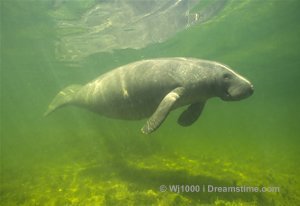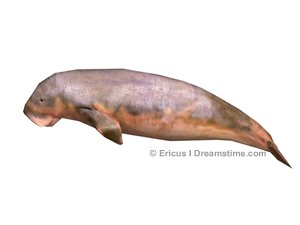Facts About Manatees
One of the most interesting facts about manatees is that they are genetically related to the elephant and not, as you might expect, to other marine species like seals.
These gentle marine mammals live in shallow coastal waters, rivers and estuaries. They are also known as sea cows because they browse on water plants. In fact they are the only herbivorous sea mammal.

There are three species of manatee:
- Trichechus manatus - the West Indian manatee found along the coasts of Belize, the Yucatan Peninsula and the Southern United States
- Trichechus inunguis - the Amazonian manatee of Brazil
- Trichechus senegalensis - found along the west coast of Africa
Together with the smaller oriental Dugong they belong to the order of Sirenia.
Physical facts about manatees
- They can reach a length of about 4.5 meters. Females are generally bigger than males. An adult manatee weighs an average of 200 up to 600 kilograms.
- The body is streamlined, with two forelimbs or flippers. With exception of the dugong the forelimbs have nails which can be used to dig up roots. Like other marine mammals they have a horizontal tail with rounded edges. West Indian Manatees are brown or grey in color and their body is covered with wrinkles.
- Typically the manatee has small eyes, a split upper lip and a somewhat bend-down snout which it uses to grasp his food, which mainly consist of water plants. Ocasionally they may eat small invertebrates or fish.
- Manatee lungs extend the lenght of the body, thus providing depth control, like a diver's trim vest. Every few minutes they surface to breath, even when they are resting on the bottom.
Other interesting facts about manatees:
- Algae growth on their skin is prevented by continuously renewing and sloughing off skin cells. Furthermore they lack the body fat that protects other marine species against the cold, which is why they live in warm (sub)tropical waters.
- Manatees are adapted to living in salt, brackish or fresh water environment. However they avoid strong currents and do not venture in deep waters. Mostly they stay within 3 - 5 meters.
- Just about the only activity these mammals have is eating. Their very slow metabolism makes them survive on little energy, but they have to keep on eating almost all the time. It so happens the sand in its food causes a manatees' molars to wear very quickly (molars are the only kind of teeth they have). However their so called 'marching molars' take care of the problem. Worn molars move to the front where they eventually fall out. Meanwhile in the back new ones slide into position from a pouch of replacement teeth. Neat!

Reproduction and mortality
Reproduction is slow, with one calf born every 3 - 5 years. Females reach sexual maturity at 5 years of age, males at 9. When a female is in estrus, she will mate with several males over a few weeks time. Normally after a one-year gestation period a calf will be born. Calves weigh about 30 kilograms. The mother will nurse the calf from tits located behind the forelimbs.
After about three weeks of breastfeeding the calf is able to digest plants. It stays with the mother for a period of two years. The mother-calf relation is also the only long-term social relationship in manatee life. Because manatees do not have natural enemies they never developed a social system for defense or food supply. They are basically solitary animals.
It is thought the manatee can reach about 50 years of age. Since they have no natural predators, boat collisions are the main cause of death among adult individuals. Investigation has shown that the problem lies in the animals hearing abiltiy and the deformation of sound near the surface. Manatees have difficulty hearing low frequency sounds. They get hit by boats because they do not hear them coming. Florida researcher Edmund Gerstein together with his wife and others have developed a kind of sonar that emits high pitches to warn manatees for oncoming boats.













